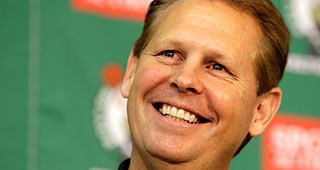The Boston Celtics ended up completing a trade a few hours before Thursday’s deadline, but no member of the Big Three was involved. Boston sent Leandro Barbosa and Jason Collins to the Washington Wizards for Jordan Crawford.
Barbosa, who tore his right ACL earlier this month, proved to be a nice trade chip with an affordable, expiring contract. There were whispers that the Celtics were floating Fab Melo in talks, but it was clear that Ernie Grunfeld didn’t want any future salary commitment.
Collins also has an expiring contract, while Crawford carries a $2.16 million salary for 2013-14 and can be issued a qualifying offer of $3.2 million in 14-15. It was expected that the Celtics would re-sign the Brazilian Blur, but Danny Ainge now will have some work to do with close to $72 million already committed for next season.
The Wizards essentially dealt Crawford for two bodies and a small amount of cap savings. Barbosa is still waiting for his MCL to calm down before undergoing surgery on his ACL and Collins will have Emeka Okafor, Nene and Kevin Seraphin ahead of him on the depth chart. The move accomplished two things for Grunfeld -- ridding himself of the somewhat enigmatic Crawford and saving more than $2 million next season. Washington now has a little more than $65 million committed to 11 players (including Trevor Ariza’s $7.7 million player option and the $7.8 million amnestied deal of Andray Blatche).
There may have been underlying issues between Crawford and Washington, but it’s somewhat surprising that they couldn’t turn him into some sort of tangible future asset. However, the Wizards have relied on better ball movement since John Wall returned from injury and a one-on-one player like Crawford simply doesn’t fit with that scheme. That made it clear the 24-year-old wasn’t a fit now or going forward.
Grunfeld himself mused that he couldn’t get much in return for Crawford, but in actuality he should have been able to land at least a late second-round pick. I mean, wouldn’t Melo (a project big man due $1.3 million next year) be at least something? Crawford has been an average NBA player over the last two seasons (at the very least in terms of PER).
Grade for Washington: D+
Ainge didn’t make a big splash, revealing that he feels the Celtics can make a run come playoff time. That’s not guaranteed. With 28 games left, surpassing Atlanta for the sixth seed is really all that Boston can hope for at this point -- and the likelihood of that happening diminished when the Hawks held onto Josh Smith. The Bucks, 76ers and Raptors are all hoping to leapfrog the Celtics down the stretch. They have just 12 home games remaining and five games against the four teams they’ll be battling for positioning.
This deal was a classic give-and-take for the front office. They added a potent bench scorer, but had to further deplete the frontcourt in the process. My expectation is that Ainge will search for a buyout/free agent big man to sign for the final two months of the season. If they don’t do so soon, Chris Wilcox will be in for increased minutes. We will also see a smaller lineup featuring Jeff Green at the four.
Crawford should improve an anemic offense that averages just 102.2 points per 100 possessions, better than only five other teams. He has averaged .511 points per minute since he was a first-rounder in 2010. Playing with a second unit in need of an offensive punch, Crawford will have plenty of shot attempts and certainly won’t pass them up.
The Celtics share the basketball extremely well. Without Rondo, only Paul Pierce and Kevin Garnett are averaging more 9.3 shot attempts per game. Crawford was playing bench minutes for Washington before he fell out of favor and shot 11.8 times.
Crawford has never and will never shoot the basketball with great accuracy, but improved selection would increase his percentages. He’ll need close to 10 shots to flirt with double figures. That’s fine with Crawford, but Doc Rivers might have other ideas. His poor percentages are a direct result of poor selection. He can finish around the rim and is a decent outside shooter, but is hitting just 34% of his long twos this year. He doesn’t shoot substantially better from three-point range (35%), but at least that shot is a more efficient one.
Conventional wisdom suggests that Crawford should get better shots in Boston’s post-Rondo injury offense, but there is risk involved. The ball typically stops with Crawford, which could hinder movement. As mentioned above, his penchant for isolation offense is the reason he fell out of Randy Wittman’s rotation.
Defense isn’t Crawford’s strong suit, but the Celtics should be able to hide him when possible. He’s undersized for a shooting guard, which doesn’t help, but an injection of effort would make up that. Rivers and Garnett have transformed poor defenders into adequate ones several times, which is promising, but doing so with Crawford might be worthy of mention on their resumes.
Grade for Boston: B+
The worst case for the Celtics here is that Crawford can’t earn minutes and becomes the ninth man off the bench. With Barbosa injured, that’s essentially the package they sent to Washington. Crawford carries future salary obligations, but his contract is very tradable.
Some will cringe, but if Crawford meshes well they could shop Courtney Lee this summer. He is set to make $5.2 million next season and with Rondo expected to return healthy, a four-guard rotation of Rondo, Avery Bradley, Jason Terry and Crawford would be undersized but feature enough defense to account for Crawford’s offensive mindset.



